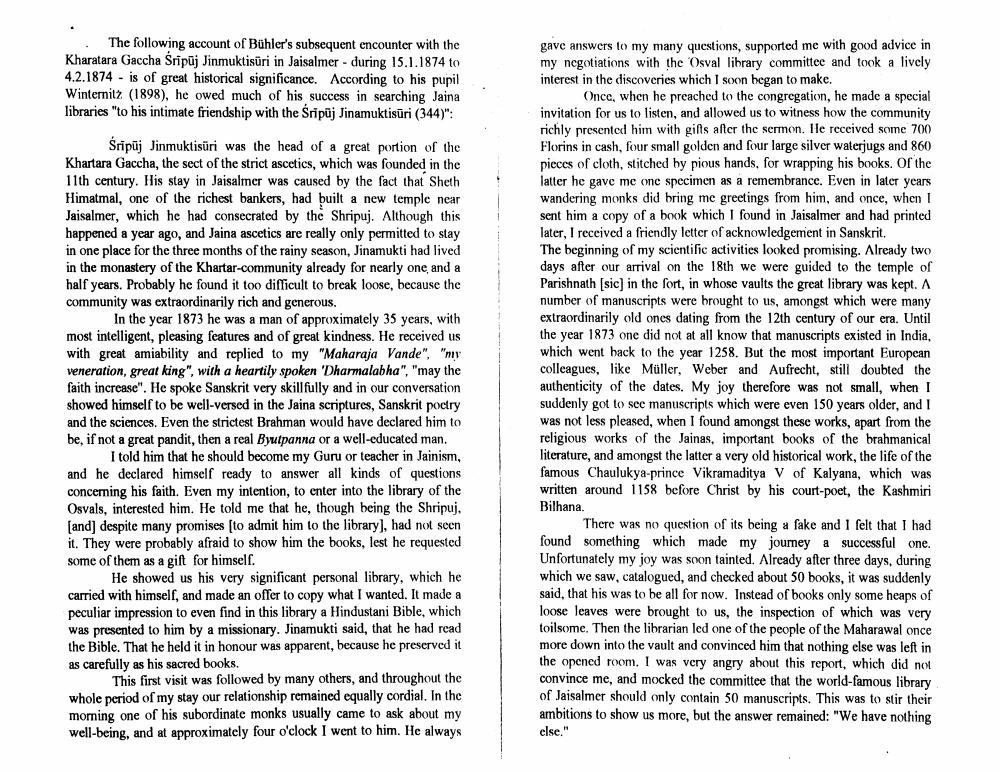Book Title: Jainism And Western World Author(s): Peter Flugel Publisher: Peter Flugel View full book textPage 3
________________ • The following account of Bühler's subsequent encounter with the Kharatara Gaccha Sripūj Jinmuktisūri in Jaisalmer - during 15.1.1874 to 4.2.1874 - is of great historical significance. According to his pupil Winternit (1898), he owed much of his success in searching Jaina libraries "to his intimate friendship with the Sripüj Jinamuktisüri (344)": Śrīpāj Jinmuktisüri was the head of a great portion of the Khartara Gaccha, the sect of the strict ascetics, which was founded in the 11th century. His stay in Jaisalmer was caused by the fact that Sheth Himatmal, one of the richest bankers, had built a new temple near Jaisalmer, which he had consecrated by the Shripuj. Although this happened a year ago, and Jaina ascetics are really only permitted to stay in one place for the three months of the rainy season, Jinamukti had lived in the monastery of the Khartar-community already for nearly one and a half years. Probably he found it too difficult to break loose, because the community was extraordinarily rich and generous. In the year 1873 he was a man of approximately 35 years, with most intelligent, pleasing features and of great kindness. He received us with great amiability and replied to my "Maharaja Vande" "ny veneration, great king", with a heartily spoken 'Dharmalabha", "may the faith increase". He spoke Sanskrit very skillfully and in our conversation showed himself to be well-versed in the Jaina scriptures, Sanskrit poetry and the sciences. Even the strictest Brahman would have declared him to be, if not a great pandit, then a real Byutpanna or a well-educated man. I told him that he should become my Guru or teacher in Jainism, and he declared himself ready to answer all kinds of questions concerning his faith. Even my intention, to enter into the library of the Osvals, interested him. He told me that he, though heing the Shripuj, [and] despite many promises (to admit him to the library), had not seen it. They were probably afraid to show him the books, lest he requested some of them as a gift for himself. He showed us his very significant personal library, which he carried with himself, and made an offer to copy what I wanted. It made a peculiar impression to even find in this library a Hindustani Bible, which was presented to him by a missionary. Jinamukti said, that he had read the Bible. That he held it in honour was apparent, because he preserved it as carefully as his sacred books. This first visit was followed by many others, and throughout the whole period of my stay our relationship remained equally cordial. In the moming one of his subordinate monks usually came to ask about my well-being, and at approximately four o'clock I went to him. He always gave answers to my many questions, supported me with good advice in my negotiations with the Osval library committee and took a lively interest in the discoveries which I soon began to make. Once, when he preached to the congregation, he made a special invitation for us to listen, and allowed us to witness how the community richly presented him with gifts after the sermon. Ile received some 700 Florins in cash, four small golden and four large silver waterjugs and 860 pieces of cloth, stitched by pious hands, for wrapping his books. Of the latter he gave me one specimen as a remembrance. Even in later years wandering monks did bring me greetings from him, and once, when I sent him a copy of a book which I found in Jaisalmer and had printed later, I received a friendly letter of acknowledgement in Sanskrit. The beginning of my scientific activities looked promising. Already two days after our arrival on the 18th we were guided to the temple of Parishnath (sic) in the fort, in whose vaults the great library was kept. A number of manuscripts were brought to us, amongst which were many extraordinarily old ones dating from the 12th century of our era. Until the year 1873 one did not at all know that manuscripts existed in India, which went back to the year 1258. But the most important European colleagues, like Müller, Weber and Aufrecht, still doubted the authenticity of the dates. My joy therefore was not small, when I suddenly got to see manuscripts which were even 150 years older, and I was not less pleased, when I found amongst these works, apart from the religious works of the Jainas, important books of the brahmanical literature, and amongst the latter a very old historical work, the life of the famous Chaulukya-prince Vikramaditya V of Kalyana, which was written around 1158 before Christ by his court-poet, the Kashmiri Bilhana. There was no question of its being a fake and I felt that I had found something which made my journey a successful one. Unfortunately my joy was soon tainted. Already after three days, during which we saw, catalogued, and checked about 50 books, it was suddenly said, that his was to be all for now. Instead of books only some heaps of loose leaves were brought to us, the inspection of which was very toilsome. Then the librarian led one of the people of the Maharawal once more down into the vault and convinced him that nothing else was left in the opened room. I was very angry about this report, which did not convince me, and mocked the committee that the world-famous library of Jaisalmer should only contain 50 manuscripts. This was to stir their ambitions to show us more, but the answer remained: "We have nothing else."Page Navigation
1 2 3 4 5 6 7
